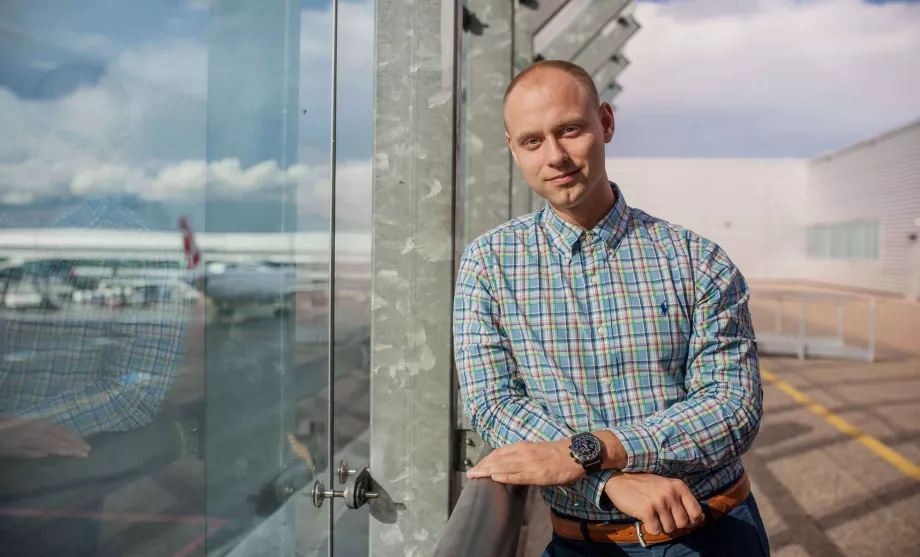Getting around Busan

The city is very large and stretched along the coast between hills for several tens of kilometres. Therefore, you almost certainly can't do without public transport or taxis.
- Find the cheapest accommodation in Busan
- buy flights to Busan
What's the quickest and cheapest way to get around Busan? Find out in this chapter.
Public transport tickets
For the entire public transport system in Busan, as well as other Korean cities, special transport cards T-money and Cashbee (former Busan Hanaro Card) are created. The Tmoney card (sometimes written as T-money) was originally created for Seoul, while the Cashbee was created for the second largest city, Busan. Over time, however, the validity of both cards has been extended to virtually all public transportation systems in Korea.
If you arrive in Busan from Seoul with a T-money card (sometimes referred to as a Korea Tour Card) or, conversely, travel to Seoul (or anywhere else in Korea) with a Cashbee card purchased in Busan, both cards will work in both cities.
You can pay for subway and bus tickets in the following ways:
- by transport card (T-money or Cashbee)
- cash (individual tickets)
- by credit card (currently this option only exists for cards issued in Korea)
Cashbee (or T-money)
Cashbee is the most common and in most cases the most convenient way to pay for tickets. If you arrive in Busan from Seoul or another city, you can also use the local T-money card under exactly the same conditions.
Cashbee is also newly promoted and sold as the Busan Tour Card.
Official information about the Cashbee Card: www.cashbee.co.kr
Where to buy Cashbee Card and how much does it cost?
The Cashbee Card itself costs 4 000 krw. This price is non-refundable and does not include any fare. You have to top it up at a separate machine and then at any machine in all subway stations across Korea, as well as at all mini-grocery stores across the country (7-Eleven, GS25, CU, Ministop, for example).
Recharging and purchasing Cashbee Card in a vending machine is cash only, but at 7-Eleven, GS25 or CU and other retailers, you can pay for the recharge with a credit card.
You can top up your Cashbee Card in Busan, Seoul and anywhere else in Korea.
How does the Cashbee Card work?
After purchasing the card, you need to top up the credit at the machine, which can be used for travel. The amount is entirely up to you, and you can top up the credit at any of the above locations. If you will only be travelling around Busan, around 5,000 to 8 000 krw per day should be enough.
From then on, you'll just attach the card to turnstiles in subway stations (when entering and exiting) or readers in buses (when boarding and exiting).
Especially when travelling by bus, it is important to remember to attach the card to the reader when getting off the bus. This is the only way to calculate the correct ticket price.
If you transfer between the metro and buses, the next journey is calculated at a significant discount. Transferring means journeys of less than 15 minutes.
How much is the fare with Cashbee?
Fares using Cashbee are always cheaper than if you paid cash for individual tickets, by 70 to 100 won.
A single subway ride in downtown Busan with Cashbee or T-money costs 1 300 krw, the further you go, the more you pay (max around 3 000 krw).
Public transport bus rides then vary by bus type from 1 130 krw for local green buses to 1 800 krw for red express buses. When you change buses, the fare is not added up, but calculated by distance (so it is cheaper than if you go 2 separate times).
Where does Cashbee pay?
The short answer is that you can pay with the Cashbee (or T-money) Card in all transport environments throughout Korea. The exceptions are long-distance buses and express trains, where Cashbee is not valid.
Individual tickets
If you're coming to Busan by rental car, for example, or are just stopping over at the local airport, it's more likely to be worth paying your tickets in cash for each trip.
Tickets differ for taking the metro and for taking the bus. For metro travel, you buy tickets from the machines at each station, where you can only pay cash, but the machines do give change. On the bus, you even pay the exact amount into the driver's box (you don't get any paper tickets back, you just drop the money into the box).
One bus ride costs from 1 200 krw to 1 800 krw depending on the type of line, a metro ride costs from 1 400 krw to 3 000 krw depending on the distance.
Metro
The entire Busan conurbation operates a unified system of subways, trains, or automatic subways, collectively called the Busan Metro. The system is interconnected, the same fare applies on all routes, you can transfer freely between all lines and find everything on a single official website www2.humetro.busan.kr.
Because of the complexity of the system, we have created a separate chapter for this form of transport, Busan Metro.
Buses in Busan
The bus system in Busan is very good and you can literally get to all corners of the city by bus. Buses run very frequently, are air-conditioned and, where possible, fast. In fact, they have special lanes in long stretches of the city centre.
Buses in Busan, however, have one major drawback: as a tourist, you have virtually no way of knowing where a particular bus will take you.
There are no maps of bus routes in Busan, and you won't find any at bus stops either. At each bus stop, there is a route of the specific line, but only in Korean.
However, you can at least plan your bus route in advance, preferably using Google Transit, which knows most of the bus routes in Busan.
Types of buses
There are three types of bus lines in Busan, in practice they differ only in fare and number of stops:
- Blue buses - most lines in Busan, medium to long routes stop at most stations along the way. Fares for 1 300 krw / with Cashbee Card for 1 200 krw.
- Green buses - local short lines, stop at all stations. Fares for 1 200 krw / with Cashbee Card for 1 130 krw.
- Red or white and orange buses - long distance express buses, stopping at main stations only. Fares for 1 800 krw / with Cashbee Card for 1 700 krw.
How to buy a ticket?
If you are using a T-money or Cashbee transport card, just put the card to the reader when you board. It will display how much money you will be charged for your ride. You can only board all buses through the front door.
When you get off (back door only), you have to put the card back on the reader. The credit balance on your card will be displayed. It is important to attach the card on exit as well, so that the fare is calculated correctly.
If you plan to pay in cash, put the exact amount of money in the cash box at the driver's desk.
Stops and intervals
All bus stops in Busan are clearly marked, unfortunately only in Korean. As a tourist, however, you can at least read which lines pass through a given stop.
Each stop is on a sign. If you're standing at a bus stop waiting for a bus, it has to stop anyway, yet it's better to signal with your arm that you're about to board. If you want to get off, you should press the "STOP" button on the door handles or on the post between the windows whenever the next stop is announced (announcements are also in English).
Most of the stops of at least some significance have electronic boards showing how long it will take for a particular line to arrive.
Buses in Busan have very short intervals. The blue and green lines run every 5-10 minutes on average, while the red lines run between 10 and 20 minutes.
Taxis in Busan
Taxis are a very popular and relatively cheap form of transport in the city. It's not a problem to flag down a taxi in virtually any neighborhood, you can usually just pull up to any even slightly main street and within 10 minutes you'll be able to flag down a taxi in outlying parts of Busan. Then you usually won't have to wait a minute in the centre.
All taxis in Busan use a taximeter and unfair practices are quite rare here. Prices vary according to the type of vehicle, but most are called Regular Taxi at a basic price.
The basic boarding rate is 3 300 krw and further calculated 100 krw for every 133 metres travelled or 100 krw for 34 seconds standing. So the exact amount can never be fully calculated in advance.
Uber or Grab apps also work in Busan, but in real life they will only call you a regular taxi at a regular price.
In taxis, you can pay with cash, credit card and T-money card
Any questions left?
If you have any questions or comments about the article...
5 comments
thank you very much, but , but? i have 10000KRW and a QR code and number, is that logical? i have to go /fly/ to Seoul to exchange it for a card, is there a logic here? klook sells to make life easier for tourists. Yes, I know ! you are also dabbling in the subject and don't understand like me. i have a site like this at the moment, i am sending you the link.Maybe you can read it better like me., thank you if you write something , with thanks, Christopher
hello, can you answer me if this voucher with QR code , which I bought on klook with a value of 10000 won is enough as a ticket?
Thank you very much for your answer. Krzysztof

Hello, I have no personal experience with this one. I'm reading the information (I'll edit the text of this guide after verification), and if you bought the "T-Money card + KRW 10,000 Balance" option, you have to exchange it for a physical card after presenting the voucher code.
The Klook website only lists two locations at Incheon Airport, so I don't know if it's just not updated or if you can actually only exchange the QR code in Seoul and not Busan.
Hello, does octopus work in Taiwan, thank you and best regards
If I purchase a T-Money card + KRW 10,000 balance, is the QR on the underground enough? Or do I still have to register it somewhere? The information is that the airport? but I am not flying to Seoul, but will arrive in Busan.
Thank you for your answer and such great information, Krzysztof

Registration of the card is not required. And one metro ride costs around KRW 1,500 depending on the distance.
i.e. what I received on my email address Voucher no.
KLK936............ with QR code print it out and it is enough to bounce and on the metro and bus.I don't need to convert it to a card? Sorry but there are some wordings translated in such a way that you can't quite understand. I have a bit of a problem with my 40 day trip and many more queries to you but this is only suitable for correspondence to your web address, thank you very much and best regards , Christopher


I made a mistake, sorry
https://koreatravelplanning.com/...0T%20money,credit%20to%20use%20the%20card.